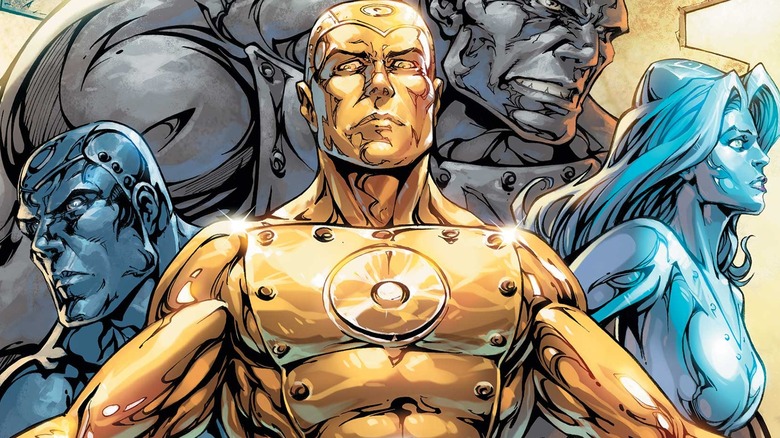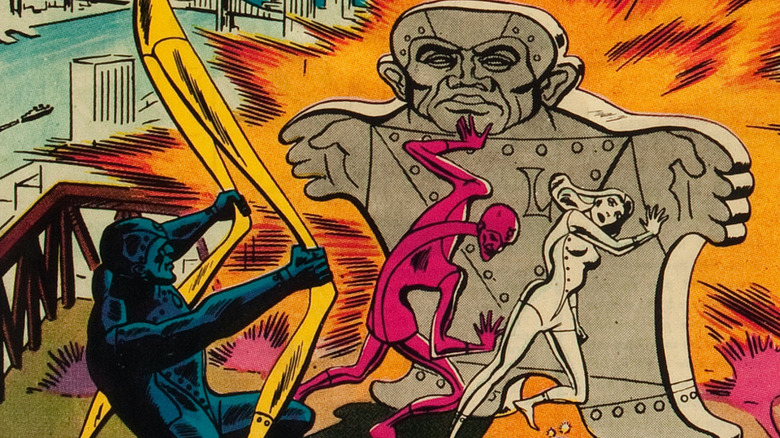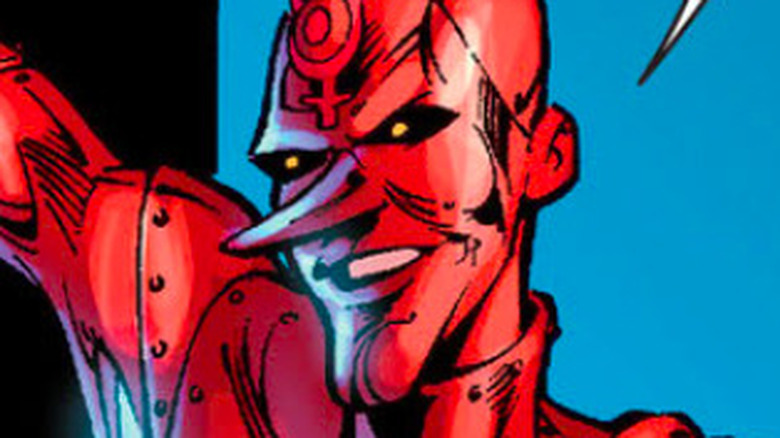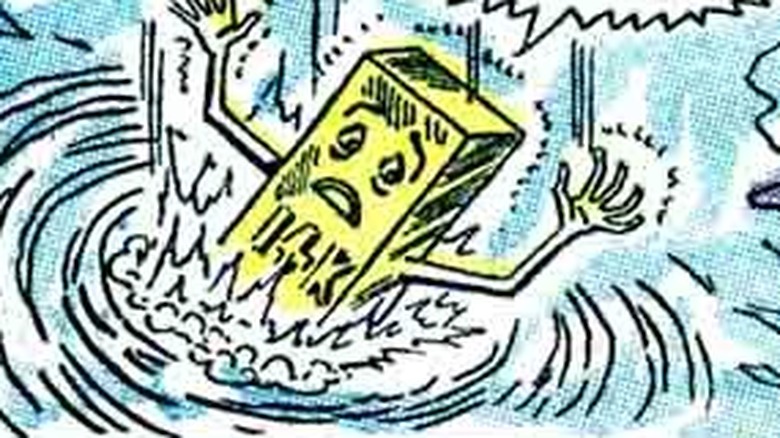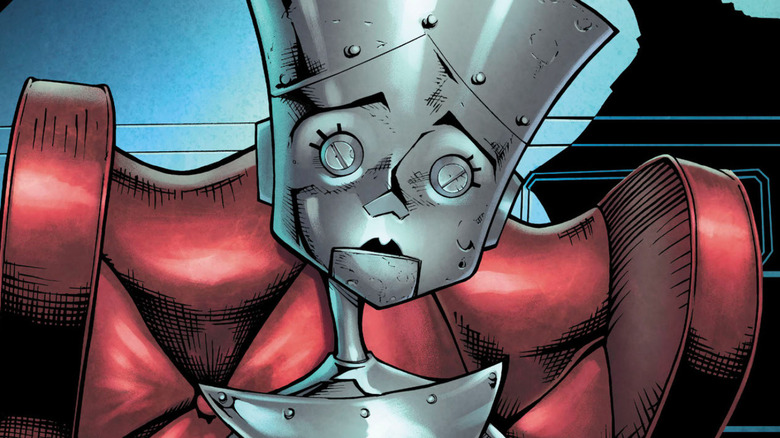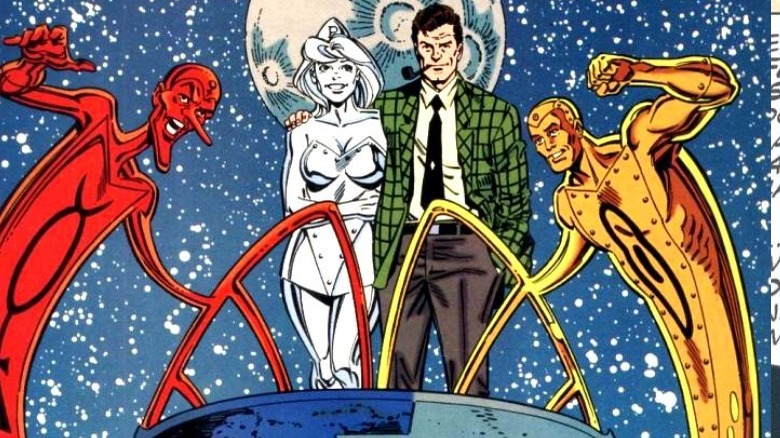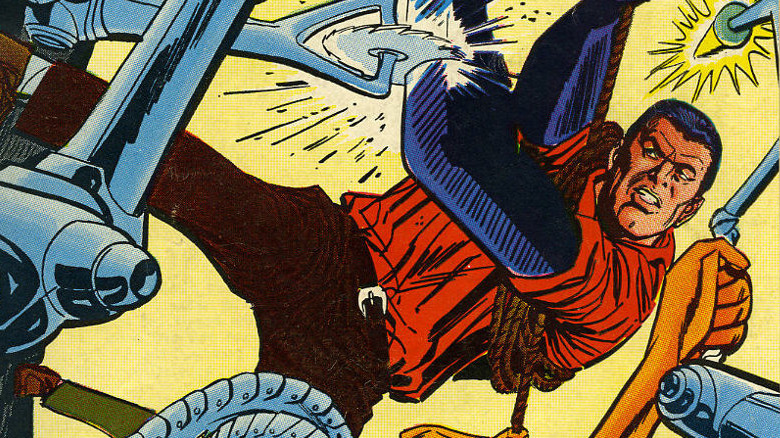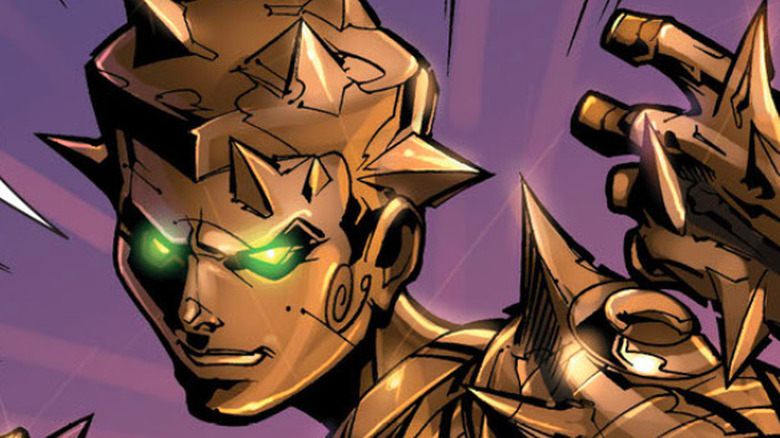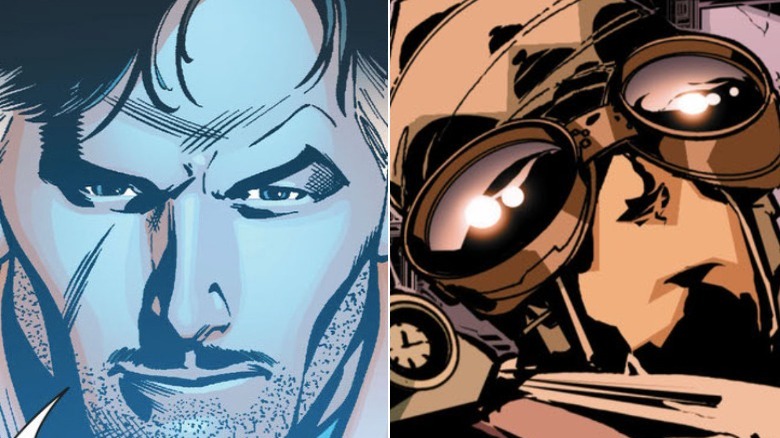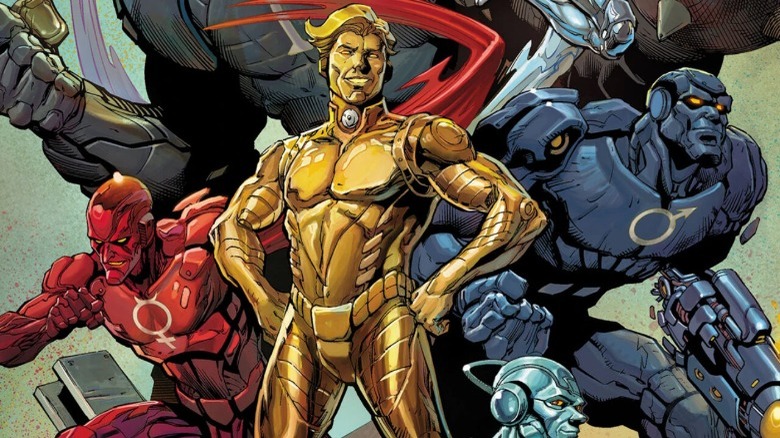The Untold Truth Of DC's Metal Men
Growing up, you may have imagined your toys and dolls having lives of their own, like in the famed "Toy Story" movies. But what about metals? That's the premise behind DC Comics' Metal Men, a group of super-hero metals that Doctor Will Magnus, their creator, brings to life with special devices called "Responsometers." Able to morph themselves into just about any shape, the Metal Men have been a DC mainstay for nearly 60 years, proving they're as adaptable and robust as the real metals themselves, even if they don't show up as often as mainstays like Wonder Woman and Superman.
That could be set to change in the very near future, however. According to the Hollywood Reporter, a new animated movie starring the malleable Metal Men is on its way, with the potential to introduce a brand new audience to Doc Magnus and his metallic creations. If you're a more casual DC fan and haven't heard of the Metal Men, that's not too surprising: though they have been around a while and have appeared in many a comic book crossover, they haven't had too many ongoing comic series or appearances outside of other media. So if you're relatively new to the Metal Men, or just need a refresher, then pick up a Responsometer or six as Looper delves into facts you might not have known about the original "smart metals."
Their first story came together very quickly
The Metal Men debut in "Showcase" #37 by Robert Kanigher and Ross Andru. Created by Doctor Magnus for the military, the original Metal Men team consists of Platinum (or "Tina," for short), Tin, Mercury, Lead, Iron and their field leader, Gold, each given life by a "nuclear-powered microscopic activator" — later renamed a Responsometer in "Metal Men" #1. Originally, the entire team (save for Doc Magnus) sacrifices itself to stop a radiation-powered creature from prehistory. The issue's ending leaves the door open for their return, however, which happens as quickly as "Showcase" #38. Two more issues of "Showcase" and an ongoing series follow.
Not bad for a series, which, according to Kanigher, came together in just over a week. As he explained to the Comics Journal (via "American Comic Book Chronicles: 1960-1964") he got the assignment to write "Showcase" on a Friday and had the script for the first Metal Man story ready by Monday. That same day, Andru completed laying out the pages, at Kanigher's request — a new practice that saved them bundles of time. By ten days, the comic was good to go.
Their personalities are their metals
What originally makes the Metal Men unique compared to other robots is that their personalities reflect the element they're made of. Mercury, for example, has a mercurial personality and therefore can be snarky, quick-tempered and self-centered... not to mention more than a little full of himself. Similarly, Tin thinks lowly of himself because he's an often underestimated metal, while Gold is noble to a fault ... or, depending on the writer, extremely narcissistic (sometimes even both).
Thanks to the magic of retcons, the explanation for the Metal Men's dispositions has changed a lot over time. In the beginning, it's said that their unique personalities are brought on by the effect auroral activity has on their original bodies, explaining why they lack those behavioral traits when Magnus sticks Responsometers in new versions of their bodies in "Showcase" #38. Over time, however, the explanation is massaged so that it's the Responsometers that give the Metal Men life which also "awaken" their inner personalities. An alternate explanation in the 1993 "Metal Men" limited series claims the robots' personalities come from humans whose psyches are accidentally transferred into the Metal Men's Responsometers, but that's since has been retconned. The 2019 "Metal Men" ongoing, however, challenges the team's central concept again by having Doc Magnus reveal the Metal Men are merely imitating aspects of his behavior. Their innate personalities are eventually awakened, however, thanks to the Nth Metal Man.
They're pretty science-friendly
While the idea of metals coming to life, complete with a personality of their own, is admittedly farfetched, Metal Men stories otherwise frequently ground themselves in real world science. Often the characters will comment on their unique properties, such as when Gold explains he can extend a mere ounce of himself into a fifty-mile long wire: a fact which happens to be completely true. Given how often real science is accurately portrayed in Metal Men stories (albeit not always: Mercury, for instance, states for years he's the only metal that's liquid at room temperature until finally admitting he's wrong in "52" #49), they are unique for their educational value.
Their early stories even include a section called "Metal Facts and Fancies" (among other names, e.g. "Amazing Alloys!") that states interesting factoids about how metals are used in the real world. Pretty impressive when you consider co-creator Robert Kanigher gleaned his science knowledge for the series on the fly with an old chemistry book, as he related to "The Comics Journal" (via "American Comic Book Chronicles: 1960-1964").
The Metal Man with no name
Learning the names of the Metal Men is pretty simple enough, as they're all named after their metals. Yet what if there are, say, two robots made out of tin? That's the conundrum Tin faces in "Metal Man" #13, where he creates a friend out of the same metal to feel less lonely. When his creation asks Tin what her name is, however, Tin struggles for an answer. While the Metal Men at first decide to let readers name the new tin robot, she officially becomes "Nameless" in "Metal Man" #15," as staying unnamed suits her fine.
Nameless becomes a regular member of the team, and begins a relationship with Tin. By "Metal Man" #33, however, the character is dropped during the "New, Hunted Metal Men" revamp (in which her teammates become fugitives) without explanation. She finally reappears in "The Brave and the Bold" #187, which reveals the Platinum Man's been holding her captive. Her reunion with the team doesn't last, however, as her body's reduced to nothing while rescuing the Metal Men, Doc Magnus, and Batman from a detonating Missile Man.
Since then, Nameless' appearances have been fairly scarce. She finally resurfaced in 2019's "Metal Men" #1 as an inactive robot Will treats as a confidante, though Tin expresses interest in activating her in #12. Interestingly, two Metal Men antagonists use her name during her long absence, namely the Calculator and an ancient, pyramid-headed menace obsessed with obtaining the "Wheel of the World."
They start out as humans... or do they?
Retcons are old friends of the Metal Men's, but one of the biggest changes takes place in their 1993 series, where their personalities are actually the consciousnesses of several humans whose psyches are transferred into the robots when an experiment by Will's brother Mike goes awry. They still possess a link to their human bodies, however, although the connection is unfortunately cut off when said bodies are crushed by debris from a battle. The humans survive, but solely in the Metal Men's bodies, now fully embracing their past identities.
It's a pretty big reversal of the Metal Men's core concept, which may explain why it's undone in the series "52." There, Will Magnus — when asked by Mercury why he doesn't reactivate his teammates — admits that the earlier "reveal" that the Metal Men's personalities come from real humans was actually a delusion of Will's, caused by a mental breakdown. As he states in the series' 22nd issue, "For a while I even thought I was a machine and you were all my flesh and blood friends..." Fitting, in a way, as the first time the Metal Men are ever portrayed as human is in 1966's "Metal Men" #22, where they're temporarily turned into flesh and blood people by the Sizzler.
Doc Magnus: Metal Man?
Several early Metal Men stories have Magnus temporarily turn into a robot, but usually only for short periods. Decades later, however, Magnus actually becomes an official Metal Men when he links his psyche to a body made out of a metal ore called veridium. As Magnus' new body is almost unbreakable, he quickly turns the tide of battle against the Metal Men's old enemies the Missile Men, and defeats their leader, Z-1, with his new capabilities. Shockingly, Magnus then incinerates his comatose human body, claiming "Doctor William Magnus was dead a long time ago — it was only a matter of time before his body caught up with him!"
From there, Magnus continues to lead the Metal Men in his new robot body, adopting "Veridium" (sometimes "Viridium") as his superhero name. The change lasts for well over a decade, but by the 2006 series "52," Will is back in his human body. While his time as Veridium isn't directly referenced, his reveal in #22 that he once mistakenly believed himself a robot seems to retcon his Veridium transformation into a figment of his imagination. The change may also be due to cosmic shenanigans, as certain events in the DC Universe's history are changed shortly before "52" in the massive event series "Infinite Crisis." Funnily enough, Doc's veridium body gets retconned in 2019's "Metal Men" #1, where it's seen among several deactivated versions of the team.
The original All-New Metal Men
Though viewed as heroes in their early days, public opinion later turns against the morphing metals in 1968's "Metal Men" #33, when their difficulties controlling their upgraded powers cause several dangerous accidents. The Metal Men's newfound notoriety even reaches the point where a special commission formed by the mayor sentences them to destruction in #37. Luckily, the team is saved by a man going only by "Mister Conan," who fakes their deaths and offers them the chance to work for his peacekeeping organization under new "human" identities. The Metal Men agree, and both their bodies and programming are altered to be as human-like as possible. They even adopt "secret identities." Platinum, for instance, becomes fashion sensation Tina Platt, while Mercury (figuratively) sets the art world ablaze as charming but temperamental artist Mercurio.
From there, the adventures of the "All-New Metal Men" (or simply the "New Metal Men") become a mixture of horror and espionage. However, the drastic revamp, devised to improve sales, only lasts from #37-41 of the original "Metal Men." After that, the series is effectively canceled, but returns twice, first dedicating #42-44 to reprints in 1972, then bringing the gang back without their human disguises for new stories in 1976 with issues #45-51.
Decades later, Dr. Chantilly Lace creates a different version of the All-New Metal Men in "Legends of Tomorrow" #4, although they have no relation to the original "all-new" premise.
The seventh Metal Man no one seems to remember
While the "core" team of Metal Men tend to be the original six members, every once in a while they get a seventh member, like Nameless and Veridium. One seventh Metal Man, however, seems to have fallen through the cracks: Copper. While a male version of the character cameos briefly in the "Metal Facts and Fancies" section of "Metal Man #1, the better-known female version is introduced in the same segment in "Metal Man" #9: her appearance isn't meant to be canon, however, as she appears merely to show readers that she and Tin can be combined into the metal bronze. She makes her in-continuity debut in "Superman/Batman" #34-36, which alters history by having Magnus claim that Copper has actually been among the team since its earliest days, built not long after the others. Issue #8 of the 2007 "Metal Men" miniseries clarifies further, showing that Copper is originally created to replace Gold when he's destroyed in battle by the Gogoloth.
There's no denying Copper is a bit of a continuity insert, which is played for laughs in the "Metal Men" backup stories in the 2009 "Doom Patrol" series, where her teammates often call her the "new kid" and no one can seem to remember that she's been with the team longer than they all realize. She's also portrayed as eager to please so she can gain some much-deserved recognition. Sadly, her efforts are in vain, as she eventually vanishes from the roster, revealed to have been decommissioned in the 2019 "Metal Men" limited series. Another version of Copper appears in the 2016 "Legends of Tomorrow"comic series, however. While this incarnation is created by Dr. Chantilly Lace, she also joins Magnus' Metal Men for a brief period.
There's more than one Doc Magnus
Genius, as it turns out, seems to run in the Magnus family. 1968's "Metal Men" #3 introduces Doc Will Magnus' brother David, an army colonel who keeps the Metal Men safe from authorities and essentially becomes their boss while Will is comatose. In 2007's "Metal Men" series by Duncan Rouleau and Pete Pantazis, David is also revealed to be a scientific genius, albeit one with a rivalry with Will. Their feud is only made worse when David starts dating Will's ex-girlfriend Helen Garin shortly after their break-up. Years later, David abducts Will while manipulating time itself to stop an ancient being called the Nameless from using the Metal Men to kill humankind. Despite their contentious relationship, the brothers rescue a young Will and his early Metal Men, but butt heads when David destroys Gold's original Responsometer, as David believes the best way to save the future is to destroy the Metal Men in the past. The two then fight the Nameless, barely escaping, although Will accidentally betrays David to regain his engagement ring for Helen. David then resurfaces on Oolong Island, having been bonded with Gold's old body by the Nameless to become the new Viridium. Infuriated by Will's failure and the resulting torture he endured at the Nameless' hands, Viridium swears revenge.
The "1993" Metal Men limited series introduces a second brother of Will's, Mike: another scientific genius whose personality ends up in Gold's body. Mike seems to have been retconned out of continuity, however.
The Tangent Universe Metal Men
What if the Metal Men had nothing to do with robots whatsoever? In the Tangent Universe, the team is a six-person detachment of the Special Forces that exists during the Vietnam War, made up entirely of normal humans with familiar code names like "Hawkman" and "Lobo," despite having no similarities to those characters' usual depictions. The name "Metal Men," in their case, is inspired by their perfect win record, as well as the metal plate in their commanding officer Marcus Moore's head. Their spotless career abruptly ends in 1968, however, while on a mission to retrieve one of the Soviet Union's Red Tornado chemical warheads from Prague. Tensions flare over just how to deal with the bomb, as Moore reveals he plans to program the missile to launch at Moscow and kill most of its population.
While the detachment bickers, the group is attacked by Soviet troops, who manage to wound all the Metal Men except Moore and Lieutenant Sam Schwartz before being gunned down. Their enemies defeated, Moore and Schwartz continue bickering over the bomb and Moore is about to shoot Schwartz before he's seemingly killed by Raven, the Metal Men's contact in the Czech resistance. Decades later, Schwartz becomes president and weds Raven, while his fellow Metal Man John Holliday, a.k.a. "Hawkman," becomes his chief of staff. The three keep Moore's thwarted plan a secret, claiming he'd died heroically trying to carry out orders... unaware that Moore's survived, and is secretly monitoring them.
The Metal Men's evil grandfathers
While Doc Magnus is chiefly responsible for the Metal Men's creation, he has a little nefarious help along the way. One influence is famed JLA villain T.O. Marrow, creator of Red Tornado's android body and, as it turns out, a professor of Will Magnus' in college. Morrow offers to fund Magnus' research into robotics after seeing an early, pre-Responsometer version of the Metal Men in action, but Will turns him down, saying he's too invested in his "electron flux" research to change gears (figuratively and literally) to work on robots. Magnus' refusal creates a wedge between the two, especially when Morrow later believes Will lied to him, not realizing Will's continued development of the Metal Men is partly accidental.
Another evil contributor to the Metal Men's existence is wealthy recluse Solomon Kahn, who offers Magnus five million dollars to continue his electron flux investigations. Unbeknownst to Magnus, the mastermind behind Kahn's generosity is the Nameless, who wishes to see if Will can recreate the Wheel of the World his ancestor Simon did, as well as lure out his time-traveling brother, David. Kahn expresses disappointment when learning Will has used his Responsometers (miniature versions of the Wheel) to give his robots free will, however, and attacks when Magnus refuses to destroy the Metal Men who've already developed independent thought. In reality, however, Kahn is really a pawn, whom Magnus and the Metal Men set free by destroying the Nameless' mystical rock soldiers, the Gogoloth.
They're not the only Metal Men out there
As Doc Magnus' Responsometers can give life to just about any metal, it's probably unsurprising to hear plenty of others have gotten the "Metal Men treatment," despite not being part of the team. In 1963's "Metal Men" #2, for example, a robot version of Doc Magnus created by Platinum inadvertently turns evil and animates six metals to replace the original Metal Men: Barium, Aluminum, Calcium, Zirconium, Sodium and the especially dangerous Plutonium. None of them have the same vibrant personalities of the original Metal Men, however, as they're solely programmed to obey the Magnus robot duplicate. Later on, the real Doc Magnus creates an entire substitute team of Metal Men with metals like Silver and Gallium, though they're destroyed when they're taken over by Darzz the Dictator. Also of note are Dr. Chantilly Lace's previously-mentioned Metal Men, whose ranks include Magnesium, Lithium and Silicon, and the Playground of Terror, an alien amusement park whose evil rides are operated by Responsometers.
As it turns out, Responsometers don't just animate metal, either. In "Metal Men" #6, Magnus, briefly turned into an evil robot by cosmic rays, transforms Oxygen, Helium, Chloroform, Carbon Monoxide and Carbon Dioxide into his Gas Gang; essentially villainous predecessors to Magnus' more heroic gas team, the Metal Mammals. Furthermore, Professor Miklos Rumpus, a wannabe rival to Magnus, creates Responsometers that bring to life a group of mannequins that collectively call themselves the Clique.
